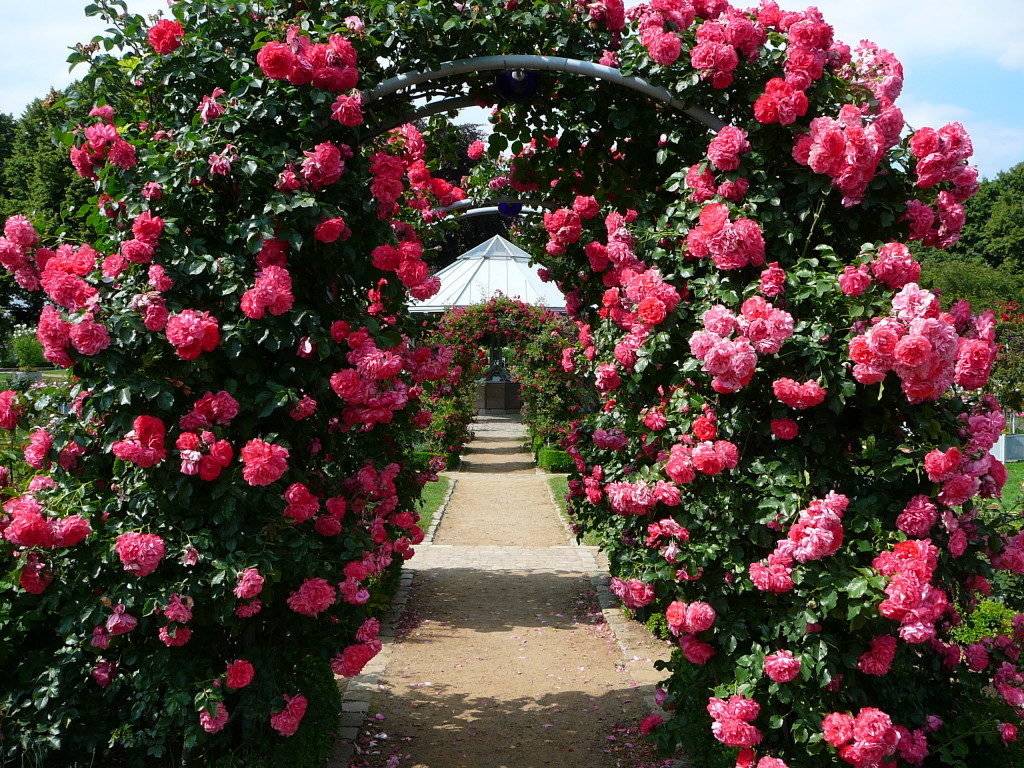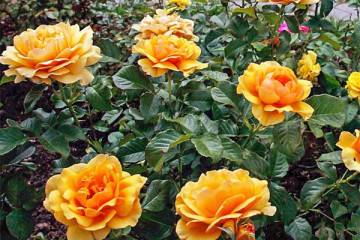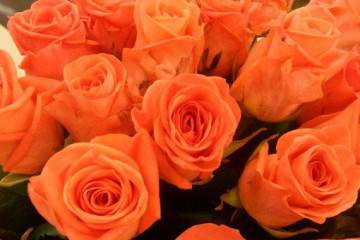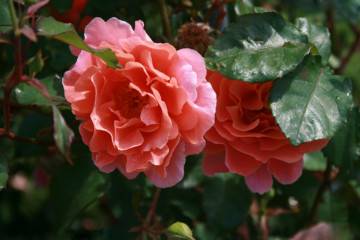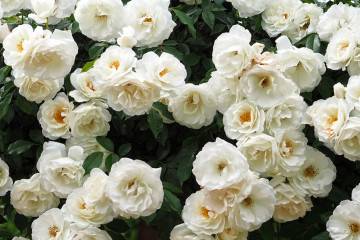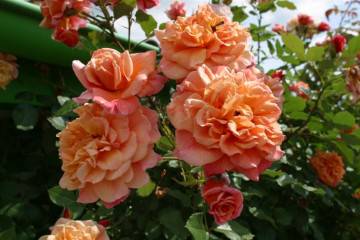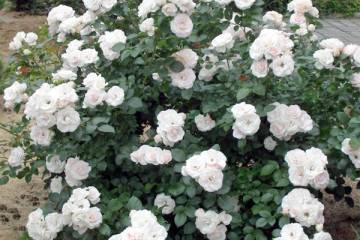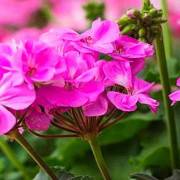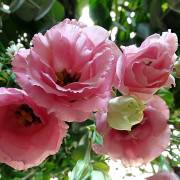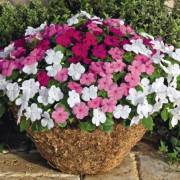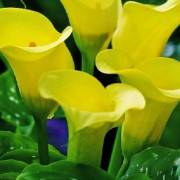Rosa Don Juan
Content:
This climbing culture grows in a bush that is decorated with large double flowers. They delight the owners all summer. Rosa Don Juan is ideal for decorating arches, walls, arbors. It will twist around any support and create a beautiful design.
Rose Don Juan - what is this variety
It is worth reading the description, familiarizing yourself with the characteristics of the flower, its appearance, the pros and cons of the variety, and learn how to grow climbing roses.
The variety was discovered in Italy in 1958. Rosa Don Juan is a perennial, climbing plant that is used in the landscape to create site design. The flower can have a support or grow without it. In the first case, it will turn out to be a wide bush, in the second - a liana, braiding a gazebo, hedge or walls of the house.
The plant has erect stems that can reach 2-3 m in height. Young branches are green, old ones are red-brown. The leaves are colored dark green. The climbing variety blooms continuously. The bushes form buds during the entire growing season. One shoot grows 3-5 buds that have a dark red or purple hue.
Advantages and disadvantages of the variety
Culture has many virtues. Their list includes not only a beautiful appearance, but also a good adaptation to external conditions.
The main advantages of the Don Juan rose:
- the ability to grow in any soil;
- frost resistance;
- long flowering period;
- resistance to fungal diseases;
- the ability to grow a culture with bushes and lashes;
- rich pink aroma;
- decorative qualities, the plant will decorate any territory;
- the freshness of the cut rose lasts for 5-7 days.
Some people refer to the minus the long and hard thorns that grow on the stem - they sometimes interfere with reaching the buds and make pruning difficult.
Use in landscape design
Beautiful, graceful shrubs adorn gazebos, fences, spread along the walls of the house. The rose goes well with various annual plants - petunia, begonia, verbena. Perennial flowers with a silvery color will help to highlight the beauty of the Don Juan variety. Rose makes a stunning duet with narrow-leaved lavender, arabis.
The plant should not be planted next to conifers. The ground around them becomes acidic over time. As a result, the rose's health worsens. It is also not recommended to plant crops in the corners of buildings. These areas are subject to strong wind gusts.
Growing a flower, how to plant it in open ground
For the good development of the rose, you need to adhere to the planting recommendations.
Planting crops in the soil is carried out in the form of seedlings. They are taken from an adult rose on their own or purchased in a store. When planting seeds, the result is not always the expected one.
The culture is planted in open ground in the country in spring or autumn, it depends on the climatic characteristics of the region. Spring treatment takes place in April or May. This time is suitable for regions with cold winters. In the southern territory of the country, roses are planted in early autumn.
The culture is unpretentious, it can grow anywhere. But there are nuances that will be discussed later. When looking for a site, you need to consider the following points:
- the flower does not accept drafts, therefore, they choose an area protected from the wind;
- the place should be well lit - this rose should not be planted in the shade;
- the culture does not accept an excess of moisture, wetlands.
Rose Don Juan loves loose, nutritious soil. It does not tolerate close contact with groundwater. The roots of the plant go down 2 meters, if there is high humidity in the soil, they will rot.
The landing should be carried out in an elevated area, devoid of stagnant water. If the soil is poor in composition, then fertilize with humus or compost.
Planting procedure step by step
Before planting, the planting material is immersed in water for 24 hours. During the day they are kept on the street, at night they are brought into the house.
The sequence of actions when planting a rose in the soil:
- A pit is prepared with a diameter of 0.6-0.7 m and a depth of 0.5 m.
- A layer of earth, compost or humus is poured at the bottom. If the soil is poor in composition, then add mineral fertilizer. 100-150 g of dolomite flour or 300 g of ash are placed in acidic soil.
- The buds are torn off from the seedling, which formed below the scion mark. The cut site is treated with garden pitch or coal.
- The seedling is placed in a hole and sprinkled with earth so that the root collar is deepened by 10 cm.If it is above the soil, then over time, rosehip roots will appear, which will start the growth of a wild culture.
If it's cold outside, cover the seedlings with plastic wrap. Open for oxygen during the day.
Plant care
After planting a rose, you need to take care of it. Although she is not capricious, you should familiarize yourself with the rules for irrigation, pruning.
Watering rules and humidity
The plant needs abundant irrigation every time the soil becomes dry. On dry days, watering should be frequent, up to 4 times a week. At other times, it will be enough to add 15-20 liters of water under each bush 2 times a week. Irrigation is carried out with warm and settled water.
Top dressing and soil quality
The climbing crop should grow in fertile soil. It is prepared from humus, turf and peat in equal proportions. Rose grows poorly in soil with high acidity. It is necessary to enter (optional) into it:
- ash;
- slaked lime;
- a piece of chalk;
- eggshells.
Pruning and replanting
The plant must be pruned annually. This is necessary to form beautiful flowers and accelerate growth.
The culture needs replanting if its original location turned out to be unsuccessful. Sequencing:
- In October, the lashes are cut in half.
- 50 cm are counted from the bush, they are dug in a circle and the plant is pulled out from the ground.
- Weak and thin roots are cut.
- In another section, a pit is prepared in size larger than an earthen coma, which is located on the roots of the flower.
- The plant is placed in a hole and covered with soil.
- Irrigate abundantly.
Features of wintering a flower
Despite the good resistance of the flower to winter conditions, Don Juan will not endure severe frosts without shelter.
The sequence of actions in preparation for winter:
- First, damaged shoots are removed, leaves, stems are removed from the supports and placed on a pillow of spruce branches.
- Spruce branches are again put on top of the lash, then covered with non-woven material.
- At the base, the bush is covered with a mixture of dry earth and humus.
- In the spring, when the first thaw appears, the rose is freed from the fabric, but the spruce branches are left until the warmth comes (this approach will protect the shoots from recurrent frosts).
- The layer of soil, which is sprinkled on the plant at the base, is raked off and distributed as mulch.
- The stems are lifted and tied to a support.
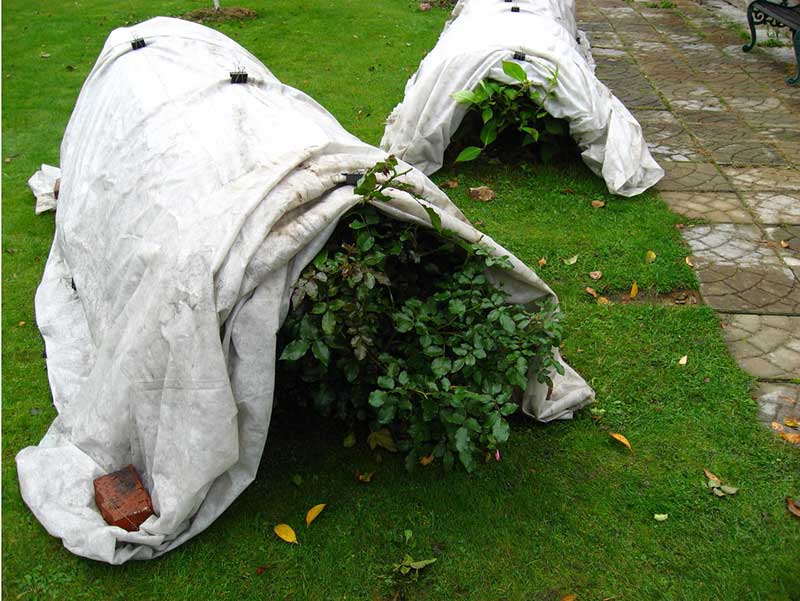
Shelter is carried out only when the first persistent frost appears, otherwise the bush will underpin and then freeze
Blooming rose
The culture blooms with cupped inflorescences of a raspberry-red hue with a diameter of 9-11 cm.
Rosa Don Juan is almost not exposed to negative environmental factors. The duration of flowering is due to the formation of buds on the shoots throughout the summer.
What if it doesn't bloom? If the rose bushes do not bloom, then a mistake has been made in agricultural technology. First, the condition of the soil is analyzed. A small amount of nutrients negatively affects flowering. It is worth making the soil loose so that the roots breathe. Then other possible reasons are assessed.
Flower propagation
The plant reproduces best by dividing the bush. When using this method, the procedure begins in the spring, immediately after the shelters have been removed.
When multiplying by dividing the bush, the plant is dug up and crushed into 2 parts, each of them should have at least 2 shoots.
Rooting of cuttings gives a good result. When grafting, the workpieces are cut from the shoots, placed in the soil at an angle and covered with transparent bags. After 6-8 weeks, roots will appear on the cuttings, they can be transplanted to a previously prepared place.
Diseases, pests and ways to control them
Despite the high rates of disease resistance of the plant, it can become infected with a fungus. This is due to excessive moisture in the roots.
The plant is affected by powdery mildew or black spot. To prevent their appearance, you need to control the amount of watering, disinfect seedlings before planting.
Roses are often attacked by spider mites and aphids. As soon as the parasites appear, the stems and leaves are processed by the foliar method.
The Don Juan rose variety is highly resistant to frost and rain. But the plant must be covered for the winter. In general, it is not difficult to care for the bushes. Timely watering, pruning and moderate feeding will allow you to grow a beautiful, branched and fragrant plant.


